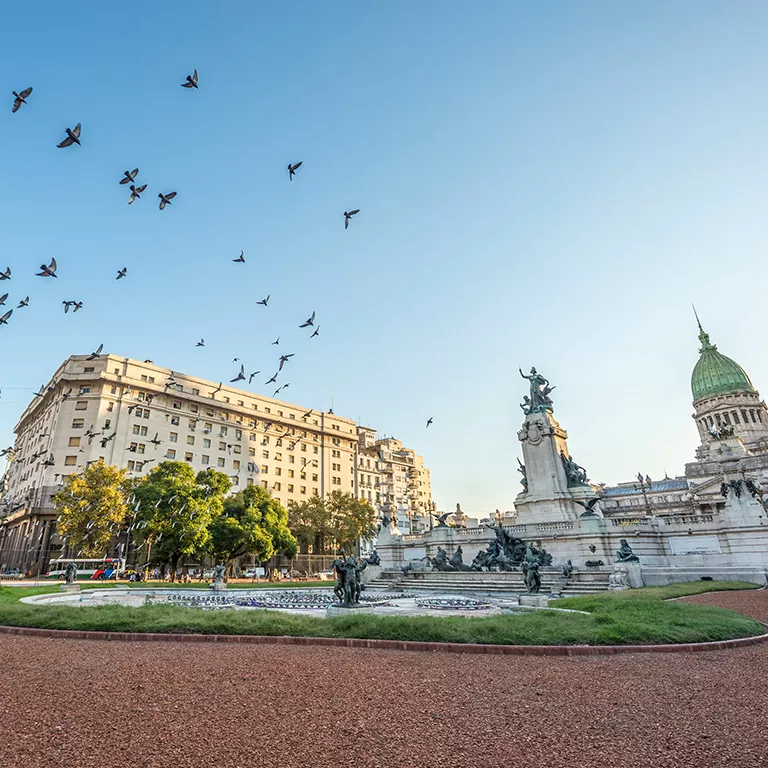
Anyone who has been to Buenos Aires surely wants to return there. One of the most charming destinations in the world, Argentina’s capital and largest city is considered the most European city in America, thanks to its climate, preservation of colonial architecture, urbanization, clean streets, and also the way Argentineans dress.
In numbers, Buenos Aires is: one of the three Latin American cities considered an alpha global city (most influential cities on the planet); it boasts the third best quality of life in Latin America, and the 62nd in the world; it has the second largest metropolitan area in South America, surpassed only by Greater São Paulo; and it has the third largest urban agglomeration, with over 13 million inhabitants.
Buenos Aires is a town that’s definitely proud of culture, which makes it one of the world’s most important tourist destinations, beginning with its theaters. Corrientes Avenue, for instance, is considered the South American Broadway, due to the many theaters all in one place. The most important is the Colón Theater, with perfect acoustics, which makes it one of the best opera houses in the world.
The Argentinean capital is an ode to reading. This is no exaggeration: there are more bookstores there than in all of Brazil, for example. The Libreria de Ávila, the pioneer in the city, is outstanding, and also Walrus Books – with its courses for future writers, and numerous English titles – , the contemporary Libros del Pasaje, the alternative Eterna Cadencia, and the charming El Ateneo, with over 120 thousand books.
Buenos Aires is also the land of the tango. A national passion, like the samba is for Brazilians, it’s easy to find artists dancing, playing and singing at tourist spots, or at the typical nights in the “milongas”, as tango houses are called – from the most simple, in every district, to the most sophisticated, such as the Café Tortoni, for instance.
The museums must never be neglected in the cultural tour of Buenos Aires. Two are extremely important: the MALBA – Museo de Arte Latinoamericano (Latin American Art Museum) – which shows works by great artists, such as Frida Kahlo and Tarsila do Amaral, besides interactive works by several artists from all over the world. Outstanding, also, is the Museo Nacional de Bellas Artes (National Museum of Fine Arts), with works by Monet, Pissarro, El Greco and others.
The delights of the open air: we can’t speak of Buenos Aires without mentioning the Caminito, a real open air museum. Its unmistakable and charming architecture has colorful windows and walls, amidst shops for tourists and restaurants. Another pleasant outing is a visit to the Floralis Generica, a monument by architect Eduardo Catalano. The famous metal flower has petals that open during the day and close at nightfall.
Still roaming the streets of Buenos Aires, you’ll reach the Plaza de Mayo, the heart of Argentinean politics. A daily stage for demonstrations, such as the famous “Mothers of the Plaza de Mayo”, the square is a real lesson in Argentina’s history. Speaking of history, the Obelisk, a few minutes’ walk from the square, symbolizes the founding of the city.
The romantic and delicious Puerto Madero
The port area, revitalized by the city government of Buenos Aires, has been a honeymoon spot for many newlyweds from all over the world. With important restaurants, the port is an invitation to romantic outings and lovely photos in the Puente de la Mujer ( Bridge of the Woman), and on the beautiful ship Fragata Sarmiento.
A city that breathes soccer
Buenos Aires is the soccer capital of the world. It’s the town that holds the most stadiums with capacity for 10 thousand or more soccer fans: 36 in all. The town has 19 headquarters of the 28 clubs that comprise the so-called Argentinean soccer elite, affiliated to the Asociacion Argentina de Futbol (Argentinean Soccer Association). The passion for soccer is so great that it has become a tourist attraction. With the name of Barrios Futboleros (Soccer Districts), the tour visits the city’s five major stadiums: Monumental de Nuñez (River Plate), La Bombonera (Boca Juniors), Nuevo Gasômetro (San Lorenzo), José Amalfitani (Vélez), and Afonso Ducó (Huracán). The tour is taken on a comfortable, air-conditioned minibus, with a guide and informative videos about each club (with optional Portuguese on earphones).











